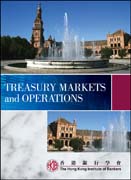
An in–depth look at how banks and other financial institutions manage treasury operations Created for banking and finance professionals with a desire to expand their management skillset, this book focuses on treasury operations in banking. It was written by the experts at the world–renowned Hong Kong Institute of Bankers, an organization dedicated to providing the international banking community with education and training. Offers a detailed look at treasury operations and how banks manage their relationships with various markets, including foreign exchange, bond markets, and derivatives Gives practitioners a thorough understanding of balance sheet management, settlement, and control Provides bankers with the specialised knowledge they need to undertake critical reviews of treasury operations in banks, manage a wide range of treasury activities, and identify risks INDICE: FOREWORD (Bank endorsement) PREFACE Part 1: Treasury Management Chapter 1: Treasury Management in Financial Institutions Learning Objectives Introduction 1.1 Review of the treasury’s functions 1.1.1 Balance sheet management 1.1.2 Liquidity risk management 1.1.3 Management of settlement / pre–settlement credit risk 1.1.4 Interest rate risk and foreign exchange exposure 1.2 Internal control 1.2.1 Organization, structure and segregation of duties 1.2.2 Position limits and VaR limits for dealers 1.2.3 Monitoring and control of dealing operation 1.2.4 Internal audit functions 1.2.5 Compliance issues 1.2.6 Code of Practice and ethical issues Summary List of key terms Study guide (five questions) Further reading/websites Part 2: Foreign Exchange, Money Market and Derivatives Chapter 2: Foreign Exchange Market Learning Objectives Introduction 2.1 The sport market 2.1.1 Spot rate 2.1.2 Value date 2.1.3 Direct and indirect quotation 2.1.4 Reciprocal rate 2.1.5 One–way and two–way quotations 2.1.6. Cross rate 2.2 Exchange rate determination 2.2.1 Interest rate parity and inflation 2.2.2 Balance of trade and payments 2.2.3 International investment and capital flow 2.3 Forward market 2.3.1 Forward rate 2.3.2 Swap and swap rates 2.3.3 Interest rate differentials and exchange rate 2.3.4 Timing options and historical rate rollovers 2.4 Hedging foreign exchange exposures and hedging techniques 2.5 Trend forecasting 2.5.1 Fundamental and technical analysis Summary List of key terms Study guide (five questions) Further reading/websites Chapter 3: Money and Capital Markets Learning Objectives Introduction 3.1 The Hong Kong dollar market 3.1.1 The peg rate system and Exchange Fund operation 3.1.2 Interbank placement and money rate (HIBOR) fixing mechanism 3.1.3 HKMA discount window, repo between CMU member banks of USD CHATS, repo of Exchange Fund Bills and notes for intraday overdraft 3.1.4 Certificate of deposit, HKD and RMB corporate bonds 3.2 International market 3.2.1 Eurodollar bond, Eurozone bond, floating rate notes, medium term notes and government securities 3.2.2 Eurodollar Interbank Money rate (LIBOR) fixing mechanism 3.2.3 Central bank bond repurchase programs and implications on market liquidity 3.3 Credit 3.3.1 Managing credit spread risk and default risk 3.3.2 Credit rating and role of credit rating agencies Summary List of key terms Study guide (five questions) Further reading/websites Appendix3.1: Calculation of year basis Appendix3.2: Details of Money Market Instrument Chapter 4 The Bond Market Learning Objectives Introduction 4.1 Bond market and the yield curve interpretation 4.1.1 Managing interest rate risk Summary List of key terms Study guide (five questions) Further reading/websites Chapter 5: Derivatives Learning Objectives Introduction 5.1 Derivatives for hedging 5.1.1 Interest rate swap and currency swap, forward rate agreements, non–delivered forward (NDF), options and financial futures 5.1.2 Credit derivatives and credit default swaps 5.1.3 Other aspects 5.1.3.1 Options pricing modeling 5.1.3.2 Dealing convention (ISDA documentation) 5.1.3.3 Accounting principles and valuation 5.1.3.4 Hedging techniques 5.1.3.5 Risk considerations Summary List of key terms Study guide (five questions) Further reading/websites Part 3: Treasury Operations Chapter 6: Treasury Operations Learning Objectives Introduction 6.1 Operations in front office 6.1.1 Interbank trading 6.1.2 Proprietary trading 6.1.3 Corporate treasury 6.2 Operations in middle office 6.2.1 Accounting and finance 6.2.2 Risk management 6.2.3 Regulatory compliance 6.2.4 Internal audit 6.3 Operations in back office 6.3.1 Cash management, payment and settlement processing 6.3.2 Trades, position and cash account reconcilement 6.3.3 Operations process control 6.3.3.1 Access right 6.3.3.2 Setting levels of authorization 6.3.3.3 Amendments and cancellation Summary List of key terms Study guide (five questions) Further reading/websites Appendix 6.1 Chapter 7: Market Risk Measures Learning Objectives Introduction 7.1 Risk considerations and control 7.1.1 Country risk 7.1.2 Counterparty risk 7.1.3 Market risk 7.1.4 Operation risk 7.1.5 Settlement credit risk 7.2 Market to market 7.2.1 Calculation of VaR and BPV 7.2.2 Tools to manage financial risk 7.2.3 Monitoring and compliance 7.2.4 Exposure limit considerations, assessment and review process Summary List of key terms Study guide (five questions) Further reading/websites Chapter 8: Payment and Settlement Systems Learning Objectives Introduction 8.1 Offshore (Hong Kong) RMB clearing and settlement system 8.1.1 Linkage of CHATS to international settlement systems including securities clearing and custody Summary List of key terms Study guide (five questions) Further reading/websites Part 4: Case Studies Chapter 9: Case Studies Learning Objectives Introduction 9.1 Risk management and control illustration 9.1.1 Operations risk on segregation of duties 9.1.2 Settlement risk 9.1.3 Liquidity risk on position hedging 9.1.4 Concentration risk on correlation of hedge fund trading strategies Summary List of key terms Study guide (five questions) Further reading/websites Glossary Index
- ISBN: 978-0-470-82757-4
- Editorial: John Wiley & Sons
- Encuadernacion: Rústica
- Páginas: 312
- Fecha Publicación: 30/09/2014
- Nº Volúmenes: 1
- Idioma: Inglés
